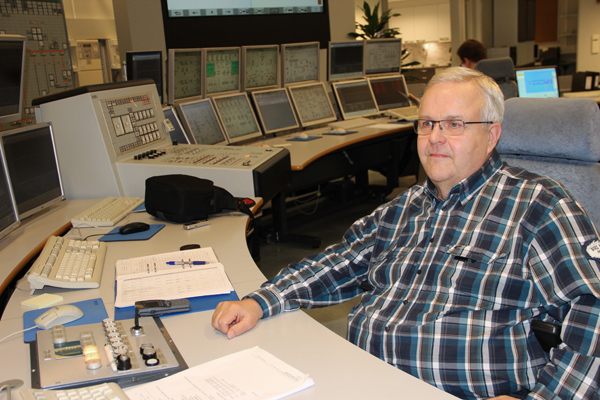Reactor operator monitors plant functions
The operators work 12-hour shifts in the control rooms of the Olkiluoto power plant. The morning shift starts at seven in the morning and leaves at seven in the evening, handing over their duties to the night shift.
The shift system rotates in periods of two days – 2 morning shifts followed by two night shifts. Then six off-days before the next two-day work period. The annual rotation includes also training days and day shifts – and the annual leaves, of course.
What does the work of a reactor operator entail?
- A reactor operator continuously monitors the reactor, its operation and behaviour, as well as the overall status of the plant, explains reactor operator Matti Tevali.
- Reactions have to be quick to everything – whether alarms or other events. The Shift Supervisor and the reactor operator may never leave the control room at the same time; one of them has to be present at all times. This means that the reactor operator also acts as a deputy for the Shift Supervisor. The operators do not leave the control room, if something happens at the plant. Any necessary actions at the plant are carried out by the Site Supervisor together with field operators.
Monitoring instruments and events
At the start of the shift, the reactor operator and the operator who is ending their shift go through any events that occurred during the previous shift. When the previous shift team has left, a shift-start meeting is held, chaired by the Shift Supervisor, to discuss any tasks that are to be carried out during the shift, such as periodic tests, work permits, failure reports, if any, and other duties and tasks that are known of.
- For the majority of the time, our work during the shift consists of monitoring display screens. Day shifts pass quite quickly, with periodic tests being carried out and people coming and going in the control room. Night shifts are not a problem either, although a 12-hour night shift may sound exhaustingly long to other people. I find this shift work system really very good, and so do many others as well – we don’t want to go back to the old system.
- The shift ends with the same routines it starts. A shift-start meeting at the start of the shift and a shift-end meeting at the end of the shift – these routines have worked well, year after year, concludes Mr. Tevali.

Reactor operator Matti Tevali monitors the operation of the reactor.
Share